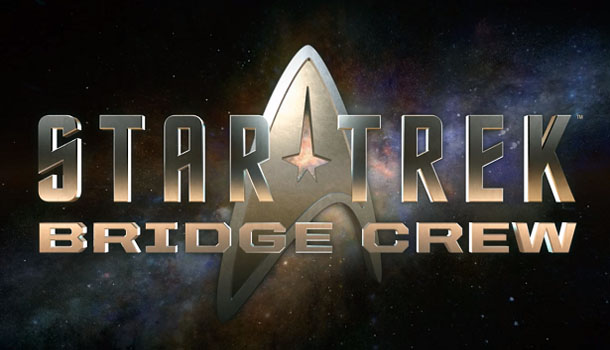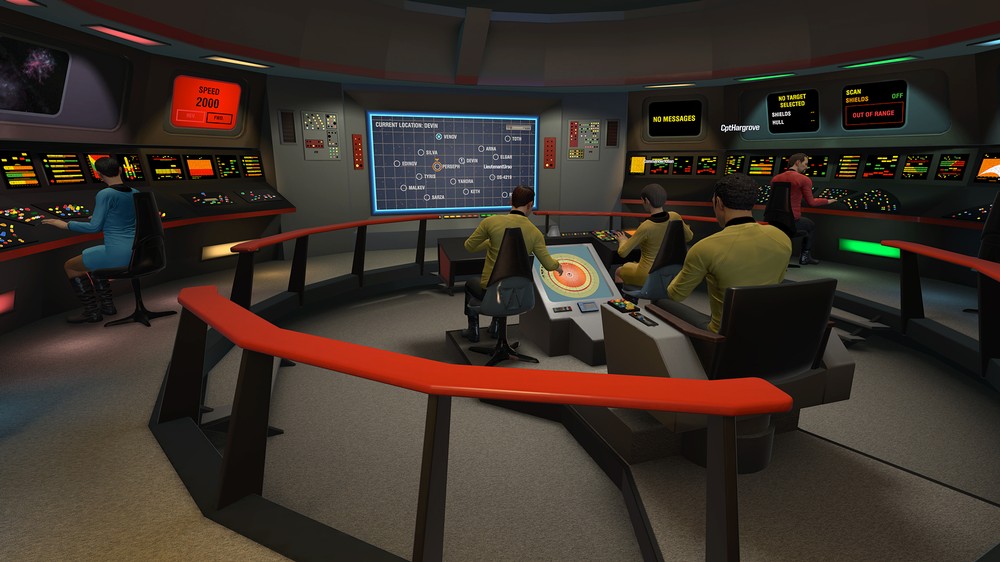I am old enough to remember watching Star Trek: The Original Series when they were first-run episodes back in the 60’s and have been a huge fan of the franchise and all the spin-offs throughout the years, including all the various video games. Since it was announced, I’ve been on the edge of my captain’s chair waiting for the release of Star Trek: Bridge Crew, and now any Starfleet nerd with an Oculus Rift and a dream of exploring the final frontier can pick their favorite duty station and join their friends in living out their wildest Star Trek fantasies.
Before we get into the game it’s probably worth noting that there are several ways to get Bridge Crew. Available on both PlayStation VR and PC, the PC version is available on both Steam and the Oculus store. There is no real difference aside from the fact that the Steam version can be used by both Rift and Vive. As we’ll discuss in a moment, the absolute best way to play Bridge Crew is with an Oculus Touch, and thanks to cross-platform matchmaking using Uplay, anyone with a copy of the game can team up with anyone on any system.
Star Trek: Bridge Crew puts you on the bridge of the U.S.S. Aegis in an extension of the J.J. Abrams universe where you are seeking out a new home planet for the Vulcans in an uncharted sector of space known as the Trench. Naturally there will be all sorts of situations that arise during your adventure including some pesky Klingons – remember…they are still the enemy in this timeline. You’ll need to master all the power and systems of your starship to complete your missions.
Bridge Crew allows you to pick and choose your position, allowing you to take control of Engineering, Tactical, Helm, or take your chances in the “big chair” and be the captain. When playing online with friends (or strangers) you can pick your position during the matchmaking process, but when playing solo, you will always need to be the captain, although you can take periodic control of other stations when the need arises.
Playing alone reminded me of the scene from The Search for Spock where Scotty says, “All systems automated and ready. A chimpanzee and two trainees could run her.” Well, in this case you are the chimp, and you get three trainees, but before taking operational control of any station you will likely want to complete the Starfleet Academy training for all the various stations. You will need to know what each station can do, because as captain you only have a limited subset of those commands available from your captain’s chair and crew menu.
Breaking it down, Engineering gives you access to power management and repair systems while Tactical selects and scans targets, operates the transporter, fire weapons and probes, and can even conduct system intrusion hacks on various systems of targeted ships. Helm plots courses, steers the ship, and selects the speed in local, impulse and warp modes. Based on whether you are playing alone or with friends, the captain either issues orders verbally through the chat mic, so those working the control stations can execute those orders, or they can control the AI crew by looking at the station for pop-up command menus specific to that station. The captain is also in control of incoming communications as well as having his/her own star map and mission summary display with primary orders and secondary objectives.
The story mode comes with a handful of missions, each about 30 minutes in length including an initial shakedown cruise that serves as a live tutorial and even ends with the Kobayashi Maru…and no, you can’t cheat. Beyond the story is the Ongoing Voyages mode that randomly creates endless missions based on Research, Rescue, Defend, and Recovery scenarios. While the solo campaign can be completed by a lone captain, these dynamic missions are best experienced with an established crew that knows how to work together.
Star Trek: Bridge Crew is more simulation and situational systems management than anything else. Even as captain, you’ll constantly be switching between displays and interaction with the other workstations on the bridge. The controls and the panels are extremely intuitive, and it will only take you a few missions before the controls become second nature, but a command overlay is only a button press away if you need a reminder of what does what. There is no denying the immersion of seeing yourself sitting in the captain’s chair with gold sleeved arms stretching out to 3D modeled hands pushing buttons and touching interactive display screens. As helmsman you even have this cool throttle you get to grip and push forward. All of the controls respond extremely well with the Oculus Touch and a realistic push or tap of the finger using the trigger and grip buttons. It’s just like having real hands.
For those looking for some added difficulty the Ongoing Voyages can also be played with the iconic bridge from the original series Enterprise. This means a whole lot of colorful unlabeled buttons that will having you leaving that controller overlay turned on for several missions. Many of your commands are even placed on a handheld tablet device you actually have to pick up and hold – remember that data pad the yeoman would always have Kirk sign? My only regret is that they didn’t have an option for a Next Generation Enterprise with the classic LCARS control scheme…maybe in a future DLC.
The mission variety in both the story and the randomized missions are excellent and require a good mix of the various controls, although depending on the focus of the mission some stations might not see as much action as others. If there is no combat, then Tactical is pretty much just scanning targets and Engineering is just managing power. One thing I found particularly interesting was the stealth aspects of some missions in which you had to reduce your signature and infiltrate enemy territory. A green circle around your ship indicates the area where enemies can detect you, and it might take some skillful piloting from your helmsman to sneak past enemy ships or sensor buoys.
Again, playing alone as captain, you have the ability to do most of this stuff from the main chair, but often you will need to take over a specific station; especially if you need to directly navigate the ship or conduct specific target scans or perform targeted system incursion hacks. The captain does have access to a central menu that offers some macro commands like Analyze Target, which has the helm fly toward the target and Tactical scan it when in range. Engage Target will have the Helm fly toward the target while Tactical will raise shield and open fire with Phasers, although you still need to manually arm Photon Torpedoes for some reason then order them to be fired. The same goes for Engineering where you can request specific power flow and repairs, or just have your Engineer balance them evenly.
The best thing I can say about Star Trek: Bridge Crew is that it is completely authentic, and you really feel like you are on the bridge of a starship; both the new one and the NCC-1701. The graphics are excellent both inside the ship and out, which you can access by an external view button. The character models look good, and your own body is physically modeled from the neck down. There is a modest attempt to let you create your own avatar, but you can only choose human or Vulcan, then go on from there. Not sure why we didn’t at least have an Orion girl since we know they are in Starfleet in this universe.
To go along with the great graphics are all the authentic sounds, musical themes, and some fantastic voice work. I was having total flashbacks to the original series when I chose the old bridge, and you keep hearing that sonar-like pinging. Things get pretty intense in combat with the sounds of your weapons firing and the explosions from incoming fire as pieces of your bridge start to spark, catch fire, or even break apart. Multiplayer supports the built-in mic on the Oculus Rift and works flawlessly, allowing you to speak and hear others talking back to you via the headset. It would have been a huge bonus to have at least attempted some sort of voice command system, if for no other reason than to allow me to say, “Engage”. To be able to simply look at tactical and say “Raise Shield” or “Fire Phasers” or look at the helm and say “Full Stop” would have been the icing on an already-very sweet cake.
Star Trek: Bridge Crew is a great game as is, but it has also laid down the foundation for what could easily be an incredible, expandable universe of adventure with future expansions and DLC. If you love Star Trek and you own a VR (any VR) then you must play this game. Hopefully you have a few VR-equipped friends who can join you, because Bridge Crew is certainly best when played as a cooperative team, but even if you are doomed to explore the final frontier with random strangers or even alone, Star Trek: Bridge Crew is easily one of the best reasons to own a VR headset and a game I have waited my entire life to play.






















